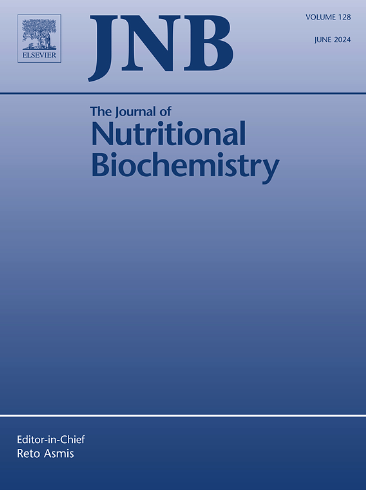成人血清视黄醇和视黄醇结合蛋白4升高与代谢综合征不良进展之间的关联:一项前瞻性研究
IF 4.8
2区 医学
Q1 BIOCHEMISTRY & MOLECULAR BIOLOGY
引用次数: 0
摘要
先前的研究强调了循环视黄醇、视黄醇结合蛋白 4(RBP4)和载脂蛋白 C(ApoC)在代谢健康中的重要作用。本研究调查了视黄醇和 RBP4 与代谢综合征(MetS)的共同关系,并探讨了载脂蛋白 C 在这些关系中的潜在中介作用。这项前瞻性研究分别纳入了 3009 名和 2724 名有血清视黄醇和 RBP4 基线数据的参与者。在对2621名参与者长达9年的随访中,分别有1136人、127人、696人和662人被分为无MetS组、恢复组、MetS事件组和持续MetS组。在研究中期,对 2316 名参与者的载脂蛋白 C1-4 水平进行了测量。视黄醇和 RBP4 水平最高(与最低)三分位数的调整后机率比(95% CIs)分别为 3.63(2.69-4.92)和 5.64(4.05-7.92),而持续 9 年的 MetS 分别为 3.63(2.69-4.92)和 5.64(4.05-7.92)。相应的危险比(95% CI)分别为:发生 MetS 的危险比为 1.67(1.39-2.01)和 1.67(1.38-2.03),恢复 MetS 的危险比为 0.65(0.41-1.03)和 0.44(0.28-0.70)(所有 P 趋势均小于 0.05)。在持续性 MetS 中观察到视黄醇和 RBP4 与 MetS 风险的协同关系。较高水平的视黄醇或 RBP4 与载脂蛋白 C1-4 浓度的增加有关,而载脂蛋白 C1-4 浓度的增加与发生和持续 MetS 的风险增加有关。根据载脂蛋白C1-4水平新开发的综合评分(ApoCS)分别解释了视黄醇或RBP4与MetS之间30.5%和24.5%的关联,而载脂蛋白C2和载脂蛋白C3则是这种关联的主要原因。我们的研究发现,血清视黄醇和RBP4水平与MetS进展之间存在显著的正相关性,而循环中载脂蛋白C2和载脂蛋白C3的增加可以解释这种相关性。本文章由计算机程序翻译,如有差异,请以英文原文为准。
Increased circulating apolipoprotein Cs are implicated in the association between elevated serum retinol and retinol-binding protein 4 and adverse progression of metabolic syndrome in adults: A prospective study
Prior research has highlighted the significant roles of circulating retinol, retinol-binding protein 4 (RBP4), and apolipoprotein C (ApoC) in metabolic health. This study investigates the joint association of retinol and RBP4 with metabolic syndrome (MetS) and examines the potential mediating role of ApoCs in these relationships. This prospective study included 3,009 and 2,724 participants with baseline serum retinol and RBP4 data, respectively. Over a 9-year follow-up among 2,621 participants, 1,136, 127, 696, and 662 were categorized into MetS-free, recovered, incident MetS, and persistent MetS groups, respectively. Midway through the study, ApoC1-4 levels were measured in 2316 participants. Adjusted odds ratios (95% CIs) for the highest (vs. lowest) tertile of retinol and RBP4 levels were 3.63 (2.69–4.92) and 5.64 (4.05–7.92) for 9-year persistent MetS, respectively. The corresponding hazard ratios (95% CIs) were 1.67 (1.39–2.01) and 1.67(1.38, 2.03) for incident MetS, and 0.65 (0.41–1.03) and 0.44 (0.28, 0.70) for recovered MetS (all P-trends<.05). A synergistic association of retinol and RBP4 with MetS risk was observed for persistent MetS. Higher levels of retinol or RBP4 were associated with increased concentrations of ApoC1-4, which were linked to a greater risk of incident and persistent MetS. A newly developed composite score (ApoCS), derived from ApoC1-4 levels, explained 30.5% and 24.5% of the association between retinol or RBP4 and MetS, with ApoC2 and ApoC3 contributing predominantly to this connection. Our study identified notable positive correlations between serum retinol and RBP4 levels and MetS progression, explained by increases in circulating ApoC2 and ApoC3 within a Chinese cohort.
求助全文
通过发布文献求助,成功后即可免费获取论文全文。
去求助
来源期刊

Journal of Nutritional Biochemistry
医学-生化与分子生物学
CiteScore
9.50
自引率
3.60%
发文量
237
审稿时长
68 days
期刊介绍:
Devoted to advancements in nutritional sciences, The Journal of Nutritional Biochemistry presents experimental nutrition research as it relates to: biochemistry, molecular biology, toxicology, or physiology.
Rigorous reviews by an international editorial board of distinguished scientists ensure publication of the most current and key research being conducted in nutrition at the cellular, animal and human level. In addition to its monthly features of critical reviews and research articles, The Journal of Nutritional Biochemistry also periodically publishes emerging issues, experimental methods, and other types of articles.
 求助内容:
求助内容: 应助结果提醒方式:
应助结果提醒方式:


